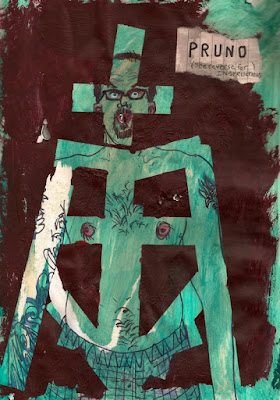24 January 2016
23 January 2016
11 January 2016
Bryan Lewis Saunders | Under The Influence
Huffing
Meth
Nitrous and Valium
Pruno (Prison wine)
Bath Salts
Pot
DMT
It’s a topic that’s inspired endless debate—the link between art and creativity and brain-altering chemicals. Usually, the drugs are a lifestyle choice of "creative" types. In the case of artist Bryan Lewis Saunders, they were a key part of the process and end product.
Saunders, a performance and visual artist, undertook a high profile experiment in creativity, starting several years ago whereby, according to the artist, he created a series of self-portraits, each one done under the influence of a different substance—pretty much an A to Z assortment, from prescription meds like Abilify and Xanax to crystal meth. Over the weeks he’d create amazing pieces, suffer mild brain damage and end up hospitalized—all for the sake of art and creation.
... While this was all done in the name of art, Saunders is quick to say that the drug use is nothing to be proud of. "To be honest I’m not proud to be on any drugs in any pictures. I think drugs make me look really ugly. And I’m really a six trick pony, but the world only likes one of my tricks. Each year 500,000 kids around the world discover drugs and so the virus never dies." Saunders, who started creating a self-portrait a day in 1995, has done over 8,600 self-portraits ...More at FastCoCreate | Bryan Lewis Saunders
09 January 2016
Differences Between Sadness And Depression
In the United States, close to 10 percent of the population struggles with depression, but sometimes it can take a long time for someone to even understand that they are suffering. One difficulty in diagnosis is trying to distinguish between feeling down and experiencing clinical depression.
A new TED-Ed video can help someone make the distinction. With simple animation, the video explains how clinical depression lasts longer than two weeks, with a range of symptoms that can include changes in appetite, poor concentration, restlessness, sleep disorders (either too much or too little), and suicidal ideation. The video briefly discusses the neuroscience behind the illness, outlines treatments, and offers advice on how you can help a friend or loved one who may have depression.
Unlike the many pharmaceutical ads out there with their cute mascots and vague symptoms, the video uses animation to provide clarity about the mental disorder. It’s similar in its poignant simplicity to the HBO short documentary, “My Depression,” based on Liz Swados’s book of the same name.GOOD Magazine | TED-Ed on YouTube
Posted at
22:37
Labels:
black dog,
depression,
diagnosis,
emotional regulation,
emotions,
liz-swados,
mental health,
neuroscience,
TED,
therapy
04 January 2016
Importance Of Electing A Mentally Healthy Narcissist
This is a severely excerpted selection from an open letter by Craig Malkin, a psychologist who studies narcissism. The original letter was posted online in Psychology Today.
... As an expert on narcissism, I'm not especially worried that narcissists might make it to the White House. According to research, they've always been there. And that shouldn't scare us anyway, because, just to be clear: Being a narcissist is not a diagnosis. It never has been. Narcissists are people higher in narcissistic traits than the average person, and while they may or may not be disordered, they all share one thing in common: They feel special. Some feel special enough to lead a nation, in fact. What we should be far more concerned about is not whether politicians are narcissists -- most are -- but how healthy they are.Learn more at Dr. Malkin's FB page.
... Politicians are groomed by us -- by our applause, by our polls, by our votes. Whatever you seem to love or hate, they'll embrace or reject. So be careful what you applaud or attack. It matters what they-- and all the little future leaders watching them -- think you want in a leader.
- Do applaud careful reflection.
- Don't applaud insults.
- Do applaud feelings.
- Don't applaud manipulation.
- Do applaud collaborative behavior.
- Don't applaud black-and-white thinking.
- Do applaud apologies.
- Don't applaud evasiveness.
- Do applaud curiosity.
Posted at
19:39
Presented Without Comment
Posted at
11:39
Labels:
art,
cartoons,
dogs,
judgment,
leonard-cohen,
philosophy,
therapy,
trump,
wisdom
02 January 2016
Dictionary Of Obscure Sorrows
The Dictionary of Obscure Sorrows is a compendium of invented words written by John Koenig. Each original definition aims to fill a hole in the language—to give a name to emotions we all might experience but don’t yet have a word for ... Watch the YouTube Series, with new episodes every other Sunday.More here
01 January 2016
Subscribe to:
Posts (Atom)



























